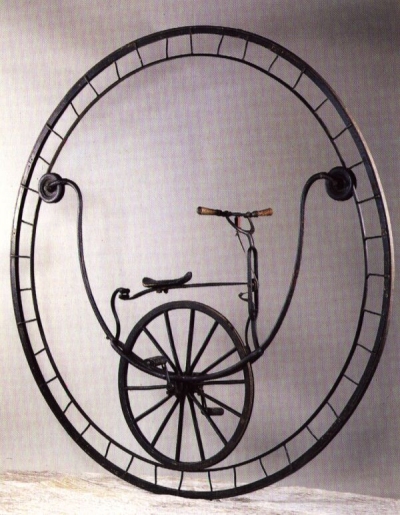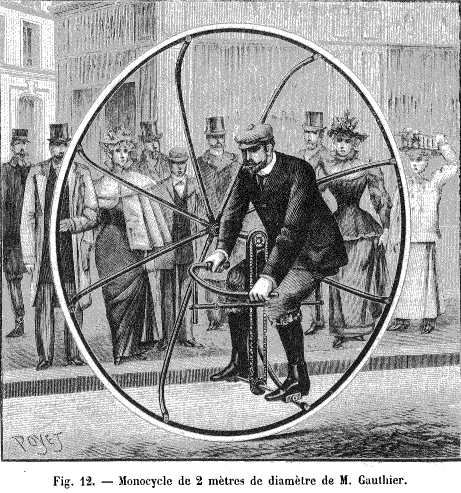 
|
|
M o n o w h e e l s. |
Diwheels now have their own page here.
(Sometimes the word "motorwheel" refers to just a wheel with an engine built into it, as opposed to having a separate motor that turns the wheel via an axle. See The Merkel Motorwheel )
Two wheels one after the other is just a motorcycle- unless what they support is actually a complete car, with gyroscope stabilisation to stop it falling over. See the next-door gallery: Gyrocars
I put this page together purely as the result of a coincidence. I happened to see photographs of the Gerdes and the McLean monowheels on the same day (in widely differing circumstances) and I thought that this must be one of the most neglected modes of transport ever. That this neglect is wholly justified is neither here nor there.
I was pretty sure I was constructing one of the most obscure pages on the Net, but as always I did a quick Alta Vista to look for any possible info on motorwheels. Synchronicity was working hard, because the Daily Telegraph had an article on the subject on that very day. See the info on Dr Owen's machines below.
Pictures of the earliest real monowheels kindly provided by Jackie Chabanais, who can be seen below gerbilling happily in his Tractowheel. He has a website at http://www.jackiechabanais.com
 | The First Monowheel?
This elegant monowheel cycle- the word "bicycle" seems somehow inappropriate, though there are certainly two wheels involved- dates back to 1869. It was built by Rousseau of Marseilles.
Presumably the bigger outer wheel made bumps in the road easier to negotiate; compare the popular penny-farthing or "ordinary" bicycle. What it does not have is the gearing-up given by the large wheel of a penny-farthing.
The machine is in the Museo Fermo Galbiati, Via Mameli 15, Brugherio, Milan, Italy. (A bicycle museum)
Bibliography:
Image, info & reference kindly provided by Paul Dunlop.
|
 | Left: The Jackson Monowheel: 1869.
They appear to have been sales agents rather than manufacturers since they offered all kinds of cycle: velocipedes, tricycles, quadricycles and the monocycle. Each one of their adverts carried an engraved picture of the week's offering. The monocycle was featured in the edition of 24 July 1870 at a price of 300 francs; this advert was the basis of the replica at Velorama. |
THE GREENE & DYER MONOWHEEL: 1869
 | Left: The Greene & Dyer Monowheel: 1869.
|
 | Left: The Greene & Dyer Monowheel: 1869.
|
 | Left: The Greene & Dyer Monowheel Patent: 1869.
|
The enigmatic part designated "I" is apparently a roof to keep the rain off; it seems far too small to be of any use.
Image & info most kindly provided by Stephen Ransom.
THE FIRST MONOWHEEL PATENT: BERGNER, 1869
 | |
Above: The first known patent for a monowheel.
A most interesting point is that Bergner states that monowheels had already been in use before this date, which implies that the Rousseau monowheel above was not the first. Perhaps there is a legion of lost monowheels... a poignant thought. |
 | The monowheel cycle of Lewis
H. Harper, from McHught, Minnesota. Date currently unknown.
|
The monocycle which was ridden by Harper in England probably should be credited to Friedrich Langmaak and Peter Streiff. Apparently this monowheel was displayed on the stand of G.H. Strong at an exhibition of machinery held in San Francisco in 1886.
Info kindly provided by Stephen Ransom.
 | This monowheel design was patented by Richard C Hemmings of New Haven, Connecticut in 1869.
|
 | A French monowheel: the design of M. Gauthier. Post 1881.
|
 | A one-horse monowheel design. Date unknown, but probably 1870-1890.
|
It was called Swallow, also Bulb Horn, (?) and was allegedly a prototype for some sort of track-laying vehicle. This sounds very strange, as it the ultra-light machine shown would appear to be about as far away as one could get from a heavy tracked vehicle. Anyway, Polish Wikipedia goes on to say:
"Swallow was one of many other vehicles built by Barycki, who attempted to construct self-propelled mechanical vehicles. The actual vehicle, with means of propulsion and a driver seat, was rolling inside huge rim, considered vehicle's "portable road". First tests were conducted by rolling the vehicle down the hill. Later, the vehicle was pulled by a horse. Lack of small, internal combustion engines forced the inventor to try out other means of propulsion; sail, pedals or a kind of a "pneumatic device". (presumably a compressed-air motor) He was against steam engines so consequently he did not apply any to his vehicle. The social environment of Barycki perceived his attempts only as fancy variation of a britzka and not as a revolutionary improvement in travelling. The inventor died in poverty, spending all his money on the development of his vehicle."
Source: Witold Rychter "Dzieje samochodu" ("The history of an automobile"), WKL, Warszawa 1983
The last bit, "The inventor died in poverty" has a plausible ring to it, as all engineers will agree. If anyone can shed any more light on this mysterious business, I will be most grateful.
DREAMING OF A MONOWHEEL: 1884.
 | I assume this is wholly imaginary design. It was found in a book on "Victorian Inventions". The original is clearly a drawing rather than a photograph.
There are two reasons why I believe this to be an imaginary machine.The obvious one is that the rider appears to be imprisoned within two complete sets of spokes. Presumably the machine was built round him.
Interesting technical features are what appear to be twin tyres, and a sort of umbrella affair over the rider's head to keep the rain off. Similar roofing structures occur in the Dynosphere and the Rose patent.
|
HARPER'S MONOWHEEL: 1892.
 | Harper's monowheel: around 1892.
|

Above: The Lewis Harper patent of 1892.
Patent info courtesy of Stephen Ransom
Mr Finch called this a monocycle rather tha a monowheel, but it is the same thing.
Note the trochoidal shape of the chainwheel, eerily reminiscent of a Wankel engine. This was presumably intended to give more constant torque when pedalling, but it is not mentioned in the text of the patent.
There are two chain tensioners; surely one would have been enough?
Source: US patent 521,786
In the early days of cycling, a "sociable" was a design carrying two or more people, preferably side-by-side to facilitate conversation.
The engraving comes from the book "Bicycles and Tricycles" by Archibald Sharp, an extremely comprehensive work that does not shrink from examining the structural strength of bicycle frames and the kinematics of chainwheels. The only reference to this monowheel in the text baldly calls it: "a sociable monocycle... for two riders." And that's all he wrote.
The rather crude drawing does not appear to be copied from a photograph, and it seemed to me unlikely that such a machine was ever built. The problems of two people co-ordinating the balancing and steering would be severe.
However, Brent Cardani tells me:
"I found that a sociable monocycle was produced by Pearce in 1881. This is according to "The History and Development of Cycles" by C.F. Caunter, published in 1955 "for the Science Museum by Her Majesty's Stationery Office". Alas, there are no pictures of the contraption, but the description in the text seems to describe exactly what is shown in the picture on your site."
An interesting point is that such a machine could only be used with two riders- unlike a conventional tandem which can be ridden by one.
This replica machine has clearly been built from the illustration above.
It featured in a sales catalogue issued by the Canberra Bicycle Museum in 2008. The accompanying text was:
"Tandem Unicycle. Replica built by Wayne Kotzur. Has not been ridden yet. 66.5 inch wheel, 2 seats. $1000"
Frankly I'm not surprised it hasn't been ridden; (yet) I would have thought it would require two people with enormous skill and perfect co-ordination to even attempt it. There is no mention of an auction, so I assume $1000 was the purchase price rather than a reserve price.
What the Canberra Bicycle Museum is doing selling items like this instead of curating them, I do not know. It is probably significant that their web address appears to have been taken over by some skeevy gambling site; I have therefore removed the link above.
This is the monowheel design of Vernon D Venable, of Farmville, Virginia. It consists of something like a normal bicycle ridden inside the big wheel.
This picture was originally published in the French scientific journal La Nature in 1897. It said: "the inventor affirms that his unicycle is absolutely stable, and can be easily steered by a simple inclination of the body to left or right". I admire (but do not share) his confidence. Early monowheels were sometimes described as "unicycles", but today a unicycle is a relatively small wheel with a saddle mounted on a tube extending above it, intended only for circus and recreational use.
Picture courtesy of Henk Schuurih.
The mechanical details of Mr Venable's monowheel; note the roller-bearing between frame and wheel.
Picture courtesy of Henk Schuurih.
Patent number 611,534 was taken out in May 1897. Here the sprocket-and-peg drive to the main wheel can be more clearly seen.
Picture courtesy of Stephen Ransom.
THE MATHEMATICS OF THE MONOWHEEL: 1899
M E Carvallo devoted some space to monowheels in his paper “Theorie du Mouvement due Monocycle et de la Bicyclette” (pub Paris: Gauthier-Villars 1899)
It seems highly unlikely that any of the practical monowheel constructors studied this.

The Finch Monocycle: 1894

The Sociable Monowheel: 1896?
The dates don't match, but maybe Sharp was describing a machine built 15 years before he was writing.

Sociable Monowheel replica: 2008

An American monowheel: 1897.

An American monowheel: 1897.

The patent drawing: 1897

The mathematics of monowheel stability, by Carvallo: 1899



